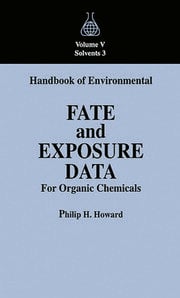1st Edition
Handbook of Environmental Fate and Exposure Data For Organic Chemicals, Volume V
In order to assess the health and environmental effects of a chemical, you need to determine the exposure of the chemical to sensitive organisms as well as to assess the likely effects. The chemicals in Volume V of the Handbook of Environmental Fate and Exposure Data for Organic Chemicals set are mostly solvents and cover many of the natural products and hydrochlorofluorocarbons and hydrofluorocarbons being considered as replacements for harmful chlorinated solvents and chlorofluorocarbons. The chemicals are listed in alphabetical order by their most easily recognized names. A cumulative index allows you to look up each chemical by chemical name synonym, Chemical Abstracts Service (CAS) number, and chemical formula. Like all of the volumes in the series, this new volume details how individual chemicals are released, transported, and degraded in the environment, as well as how they are exposed to humans and environmental organisms.
Features
Acknowledgments
Explanation of Data
2,2'-Bipyridine
Bis(2-chloroisopropyl) Ether
Bis(2-chloro-1-methylethyl) Ether
2-Bromo-2-chloro-1,1,1-trifluoroethane
2-Bromotoluene
3-Bromotoluene
4-Bromotoluene
n-Butane
1,3-Butanediol
n-Butyl Chloride
Butyric Acid
Chloroacetic Acid
Chloroacetonitrile
1-Chloro-2-propanone
2-Chloro-1,1,1,2-tetrafluoroethane
Cumene
Cycladodecane
p-Cymene
1,2-Diaminoethane
1,2-Dibromo-1,1-dichloroethane
1,2-Dichloro-1,1-difluoroethane
Dichlorodifluoromethane
1,1-Dichloro-1-fluoroethane
2,4-Dichlorotoluene
2,6-Dichlorotoluene
2,2-Dichloro-1,1,1-trifluoroethane
1,2-Diethylbenzene
1,3-Diethylbenzene
1,4-Diethylbenzene
Dipropylamine
Dodecane
Ethyl n-Butyrate
Ethyl Chloroacetate
Ethylene Dibromide
Formic Acid
Fumaric Acid
2-Heptanone
Hexabromobenzene
Hexacloroacetone
4-Hydroxy-4-methyl-2-pentanone
Isobutyric Acid
Iso-octane
Isooctyl Alcohol
Isopentane
Isosafrole
(D)-Limonene
Limonene
2-Mercaptoethanol
4-Methoxy-4-methyl-2-pentanone
2-Methyl-5-ethylpyridine
2-Methylpentane
2-Methylpentanedinitrile
Methyl Propionate
2-Methylpropyl Isobutyrate
Methylpyridine
N-Methylpyrrolidone
Oleyl alcohol
Pentafluoroethane
n-Pentyl Alcohol
Propane
Propionic Acid
1-Propoxy-2-propanol
n-Propylbenzene
2-Pyridinecarbonitrile
3-Pyridinecarbonitrile
2-Pyridineethanol
Safrole
Sulfolane
1,1,1,2-Tetrachloro-2,2-difluoroethane
1,1,1,2-Tetrafluoroethane
Tetrahydrofurfuryl Alcohol
Tetranitromethane
1,1,1-Trichloro-2,2,2-trifluoroethane
2,2,4-Trimethyl-1,3-pentanediol
Cumulative Index of Synonyms
Cumulative Index by CAS Registry Number
Cumulative Index by Chemical Formula
Biography
Philip H. Howard
"This handbook assembles much valuable information from a wide variety of sources. It is a tool engineers concerned with any of these materials will want on their bookshelf."
-Chemical Engineering Progress, April 1999


